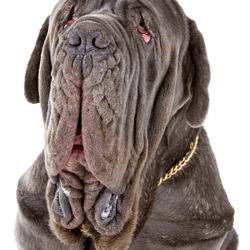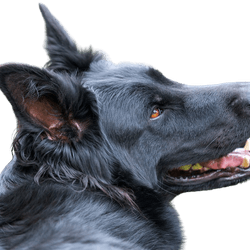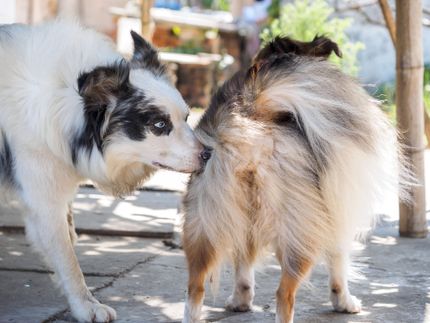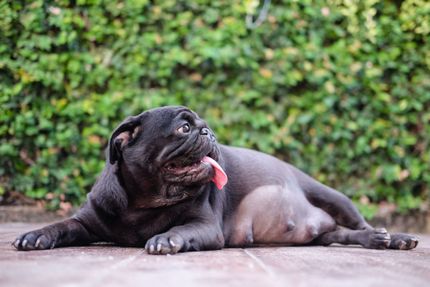
Weimaraner Breed description: Character & Co
Weimaraner
Facts & Origin
What is the origin of Weimaraner?
Not much is known about the origin of the Weimaraner. The breed probably descended from the Hubertus Bracke, crossbreeds of Arabian greyhounds. The extraordinary coat colour and the physique indicate crossbreeding with Great Danes.
It is certain that at the beginning of the 19th century grey pointing dogs were kept at the court of Weimar by Grand Duke Karl August. It was a privilege to own this dog, only family members of the duke and followers of the aristocracy were allowed to do so.
In the 19th century, the Weimaraner was bred by hunters in Thuringia exclusively for performance. It was not until 1890 that a stud book was created for the breed. A club for pure breeding of the silver-grey Weimaraner pointing dog was founded in 1897, from which today's German breeding club emerged. Since then, the Weimaraner has been bred in pure breeding.
At the end of the 19th century some of the dogs were long-haired. In the beginning these types were undesirable, today both types of coat are allowed in breeding.
The Weimaraner is an FCI recognised dog breed. It is not a list dog.
What are the breed characteristics of Weimaraners?
The Weimaraner is a versatile hunting dog. Its tasks as a hunting companion include
- pointing out game
- to retrieve shot game, also from water
- search for shot animals
This dog is persevering when searching game and knows how to use its extremely fine nose. Hunters appreciate its sharpness when sniffing out game and predators.
The Weimaraner is bred for hunting, with its fine nose it is also suitable for mantrailing and as a rescue dog. It is not a dog for first-time owners.
You should think of this before buying a Weimaraner.




| Alternate Name | - |
| Origin | Germany |
| Life expectancy | 12 - 14 years |
| Care requirements | low-maintenance |
| Activity level | high |
| FCI group | Continental Pointing Dogs |
| AKC group | Sporting Group |
| KC group | Gundog Group |
Weimaraner mixes
Attitude, character and temperament of the breed
What are typical character traits of Weimaraners?
Weimaraner:
- confident personality
- intelligent
- energetic
- alert
- reliable
- fast
- hardly vivacious
They show a noble reserve towards strangers. Weimaraners protect and defend their territory and their reference person without hesitation.
Your Weimaraner needs a loving, sensitive and consistent education. If you train your Weimaraner puppy well, you will end up with a reliable partner who will build up a very firm relationship with you.
The passion of a Weimaraner is hunting. If you don't want to use your four-legged friend for hunting, you will have to find another way to keep this agile dog occupied. A long daily walk is a basic requirement. Besides physical exercise, your dog wants to be mentally stimulated too. One way to do this is with search games and dummy training. During your daily walks around your area you should always be aware of your dogs innate hunting instinct. Your task is to keep this instinct under control.
You should not leave your Weimaraner alone for too long. It watches you closely, quickly learns to open doors and a fence does not form an obstacle for them.
An occupied, well-trained Weimaraner in experienced hands can be a fantastic partner and family dog.
A Weimaraner is fast, it can reach top speeds of up to 55 kilometres per hour.
Character
Usage



Health and breeding information
What are typical diseases of Weimaraners?
Weimaraner are considered a healthy breed. Due to their size, there can be individual problems.
- Hip joint dysplasia (HD): Hereditary damage to the hip joints. Affected dogs find it difficult to stand up and have difficulty walking.
- Stomach twist: The stomach twists around its own axis. This closes the entrance and exit of the stomach, while the digestion process continues. The resulting gases cannot escape and the stomach becomes bloated.
- Epilepsy: occurs occasionally. The dogs suffer from seizures for which there is no apparent cause.
What should be considered in regards to Weimaraner breeding?
In Germany, this breed is bred especially for hunting. In Weimaraner breeding, the breeding animals are not only selected for their beauty, they are also judged by performance, health and character. Before a Weimaraner is accepted into breeding, they must provide proof of successfully completed hunting examinations, take a character test and be examined for hip joint dysplasia. A Weimaraner from good breeding costs about 1500 Euro.


Appearance and coat of the Weimaraner
Your Weimaraner is an elegant, large dog with a characteristic coat colour. Its body is strong and sinewy, the broad, relatively long ear are a striking feature.
Weimaraner are bred in two types, short-haired and long-haired.
In the short-haired version the coat is short, strong, dense and smooth. The short-haired type hardly develops an undercoat.
In long-haired animals the top coat is 3 to 5 cm long on the sides. It can be slightly wavy or smooth. Some dogs develop an undercoat, others don't. The tail has a flag and the spaces between the toes are hairy, the coat on the head is slightly shorter. The long hair is inherited recessively. That means, even short-haired parents can have long-haired puppies.
The coat is easy to groom. You only need to brush it from time to time.
Colours:
- mouse-grey
- silver grey
- silver
White markings are only permitted on the toes and to a small extent on the chest. Some animals may have a dark eel line on their back.
Your Weimaraner looks at you with light to dark amber eyes. Weimaraner puppies have bright sky-blue eyes. At birth they have black tiger stripes, which disappear after a few days.
What is the average size of a Weimaraner?
Bitches grow to 59 to 63 cm, males 62 to 67 cm.
How much does a Weimaraner weigh?
Bitches weigh 25 to 35 kg, males 30 to 40 kg.
What is the average age of the Weimaraner?
Weimaraner reach an age of 11 to 14 years.
| Fur length | short |
| Fur | - |
| Ear shape | Floppy Ear |
| Tail | lang |
| Anatomy | slim, sporty |
| Size ♀ | 62 - 67 cm |
| Weight ♀ | 20 - 23 kg |
| Size ♂ | 59 - 63 cm |
| Weight ♂ | 23 - 25 kg |
| Suitable For | - |
Colors





Known Diseases
Epilepsy
Definition: Dog has epilepsy if, for example, at least two epileptic seizures occur more than 24 hours apart.
Hip dysplasia (HD)
The hip dysplasia or hip joint dysplasia of the dog (HD) is a maldevelopment of the hip joint.
Gastric torsion
Gastric torsion is a disease in which the stomach rotates around its own longitudinal axis. The cause of the disease is not known.
FAQ
-
A Weimaraner from a good breeding costs about 1500 Euro.
-
The Weimaraner is a hunting dog and therefore not primarily bred and suitable as a family dog. However, he can be integrated into a family as a member.
-
No, the Weimaraner is not considered dangerous and is not a listed dog in Germany, Austria or Switzerland.
-
Anyone who has a certificate of competence can keep a dog - even a Weimaraner. Age restrictions for dog ownership are different in every country.
Other large dogs
Useful Articles
You can find articles that might interest you in the dogbible blog to match your favorite breed.
Visit our magazineto stay up to date on dog trends.
To find out more, view our Privacy Policy
Find here the breed that suits you and find out what character traits it has. Here you can also learn more about the origin, size and weight of your favorite breeds.
Matching your favorite breed, you'll find articles that might interest you on the dogbible dog blog.
Bach flowers for dogs - an overview and tips
5 tips for hiking with your dog in Tyrol
Lyme disease in dogs - symptoms & treatment and why its so dangerous



























